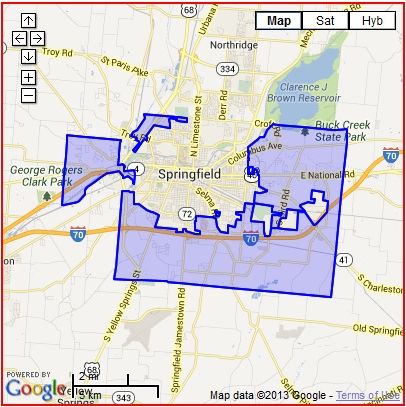Springfield Township Elected Officials / History
People  Pride
Pride  Progress
Progress
-

Tim Foley, Township Trustee
Tim began serving the Township in 2008 and is on his 5th term.
Current President of the Clark County Township Association (10 Townships)
Member of the Ohio Public Works Integrating Committee District 11
Member of the Clark County Solid Waste Policy Committee
Member of the Clark County Local Officials Government and Citizens Advisory Committee
Member of the Clark County Enterprise Zone #194 Tax Incentive Review Committee
Member on the Clark County Transportation Coordinating Committee
937.399.2900 (W)
937.323.1322 (H) -

Dan Detrick, Township Trustee
Dan Detrick, a lifelong resident of Springfield Township, was appointed on July 1, 2025, to fill the unexpired term of James Scoby. A graduate of East Tennessee State University with a degree in Business Management, Dan brings more than two decades of entrepreneurial experience as the owner of Otto Paintz. His background combines hands-on technical expertise with leadership in managing teams, operations, and budgets.
Dan is also a proud alumnus of Shawnee High School, where he played tennis before continuing the sport at East Tennessee State University. He and his wife, Christy, have four children who also attended Shawnee High School.
With deep roots in the community, Dan is eager to give back to the township that has shaped his life. -

John Roeder, Township Trustee
John Roeder was elected as trustee in 2018. John has been a lifelong resident of Springfield Township for over 64 years, graduating from Shawnee High School in 1974. John had worked for the township during the summer in high school and full time after graduating for approximately 2 years performing various duties.
In 1978, John began his career with Ohio Edison Co., where he steadily advanced from lineman to Operations Manager for the Springfield Line Department, retiring in 2021 after more than four decades of dedicated service. John also served the community as a member of the Springfield Township Fire Department for 45 years, including 13 years as Fire Chief from 2004 to 2017. His leadership and service left a lasting impact on the department and the township.
John and his wife, Cari, have been married for over 47 years. They have two sons, Steve and Adam, both of whom served on the Fire Department and continue to live in the township with their families. John and Cari are proud grandparents to three grandchildren, all of whom attend school in the Clark-Shawnee school district.
937.408.6617 (C) -

Mark Smith, Fiscal Officer
Mark was appointed as the Fiscal Officer in May 2019 and is a local retired business owner from the Medical Equipment Industry over the past 30 years. Mark is experienced using the State required programs and is responsible for maintaining the overall financial controls established by the Ohio State Auditor as it relates to reporting the Tax Revenues and Expenditures by the Township. He brings his experience as a former business owner and earlier training in accounting as an asset to the Township.
937.XXX XXXX (C) -

Jennifer Tuttle, Township Administrator
Jennifer Tuttle was appointed Administrator for Springfield Township on June 5, 2023. Prior to the appointment, she served as the Senior Planner/Zoning Inspector with Clark County Community and Economic Development. Her previous experience also includes four years with the City of Springfield Community Development Department and 18 years at Springfield News-Sun/Cox Newspapers.
As Administrator, Jennifer oversees the day-to-day operations of Township services. Jennifer is a member of the Ohio Township Association, Ohio Code Enforcement Officials Association, and American Planning Association. She was recognized as an Ohio Township Association Leadership Academy (OTALA) Graduate at the 2025 Ohio Township Association (OTA) Winter Conference & Trade Show.
Office: 937-322-3459 Ext. 11
Cell: 937-920-0761
Email: jtuttle@spfldtwp.org
Township History
Springfield Township in Clark County is one of 1308 Ohio townships. Our township was established in 1818.
The Pilgrims brought the township form of government to America in 1620. This government type is considered the earliest in American history and is still found in 22 states.
In Ohio the township predates our state government. The townships' size is determined by the Congressional Acts which established the various land grants. Ohio land grants were divided into townships that were 6 square miles. Congress set aside sections in each township for schools and religious institutions.
As the Ohio territory became populated it was only natural that the surveyed townships become the basic unit of local government. In 1804 the elected officials of a township consisted of 3 trustees, a clerk, 2 overseers of the poor and a sufficient number of supervisors of the roads, in addition to justices of the peace and constables. A township treasurer and assessor were later added.
Today, like in 1804, the Ohio township is a political subdivision of the state. As such, it only has these powers granted to it by the state legislature and performs functions defined by the state.
To keep pace with the changing times, and growing demands, the functions, duties and obligations have changed over the years.
Today the largest township function is road maintenance. Currently, Springfield Township takes care of 82 miles of roadway in a 33 square mile area.
There are 3 Trustees and one Fiscal Officer, each elected for a 4 year term to direct Township business in Ohio. Clark County has 10 townships with Springfield Township being the largest with 13,424 citizens.
Officially, Trustees and the Fiscal Officers fulfill their jobs on a part-time basis, but they are always ready to meet their responsibilities and put in many hours of work to serve their constituents. Their intimate knowledge of their community, its needs, and its citizens, enable them to offer more personal service than any other unit of government.
Your Tax Dollars at Work
Learn more about how your township tax dollars are spent. Visit Ohiocheckbook.com for more information. Opens in new window.
Springfield Township Map

This is a representative map, not to scale.